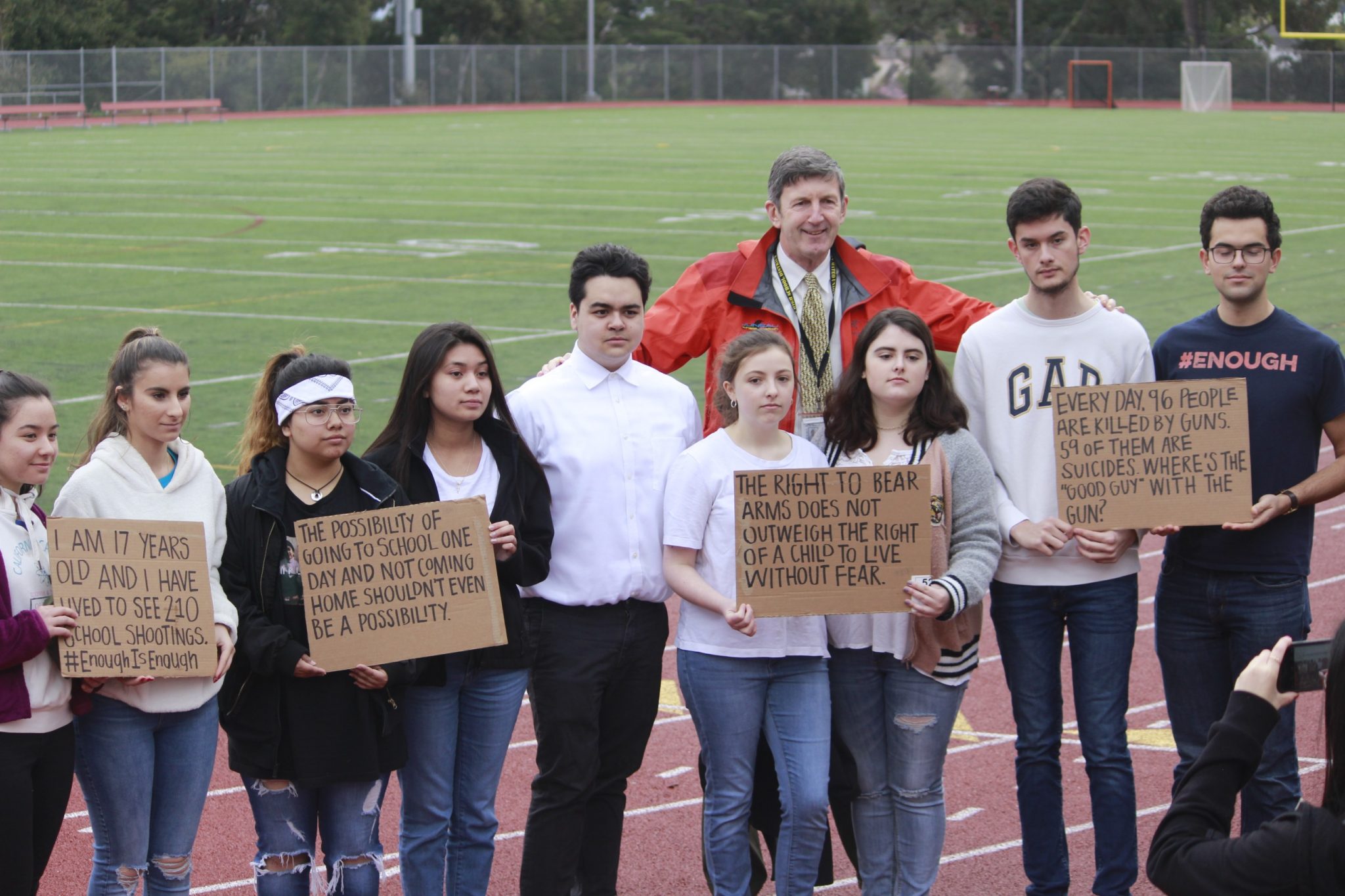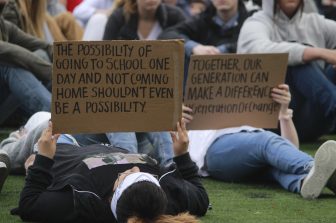
By Harbani Jaggi and Josette Thornhill

Near the beginning of third period on March 14, hundreds of Aragon students, joined by visitors, staff, faculty and young children, walked out onto the football field to honor the lives of the 17 people killed in the Marjory Stoneman Douglas High School shooting one month before.
Attendees left their classrooms to lay or sit on the football field for 17 minutes of silence as, each minute, event organizer junior Cassius Hayes listed off the name of each victim from the shooting.
“The walkout is about honoring the students and the staff who lost their lives in Stoneman Douglas,” Hayes said. “It’s also showing that, as students, we have a voice and we are calling for action in terms of getting stricter gun control laws.”
“For the most part, students will come to realize that they have a voice, and what they say matters and we can get stuff done if we put our mind to it. Even though this is a small action, this can lead to bigger things being done.”
Hayes met with the administration and student groups to organize the logistics of the walkout, as well as working to promote the message behind it.
“For the most part, students will come to realize that they have a voice, and what they say matters and we can get stuff done if we put our mind to it,” Hayes said. “Even though this is a small action, this can lead to bigger things being done.”
Though the walkout was not openly endorsed by the administration, school officials, including Principal Patricia Kurtz, supported the students’ right to express their beliefs through demonstration.
“Each student … could go out to the field if they wanted to, or if they did not want to participate in what was going on, they could [stay in their classes],” Kurtz said. “Students have a voice — you’re eventually going to be voting — so you have a right to let your feelings be known.”

The administration agrees that there are benefits to students participating together in a such an event.
“I would say that part of the educational process is teaching students about our democratic process,” said Vice Principal Lisa Warnke, “but in the end, the school is a place of learning and instruction, and I think that’s the most important thing.”
Although the administration was predominantly cooperative with the organizers, student activists did face backlash. Junior Mayuko Boffelli encountered various negative responses on social media while posting about the walkout on the March for Our Lives San Mateo Instagram page.
“Some people have [messaged] us through Instagram or commented [on our posts], saying, ‘This movement isn’t going to do anything, it’s a joke,’” Boffelli said. “I try to remain factual … I act more on logic and reason than with emotions. As the March for Our Lives [organizers], we’re trying to be as inclusive as possible, so I don’t want people who are commenting negative things to get the wrong idea [about the movement].”
In a letter posted on the district website, SMUHSD Superintendent Kevin Skelly addressed the Stoneman Douglas shooting by reassuring parents of the statistical improbability that SMUHSD students would ever be victims of a mass shooting.
During the walkout, students laid and sat down on the football field, listening to names and ages of children who had recently passed away. Junior and student organizer Kennedy Mallard recognized how she could have been in the crosshairs of a school shooting.
“I’ve always believed in stronger gun control, but … after the Parkland shooting, it hit a little closer to home. They were students, they were high school students, and it easily could have been students from Aragon. It could have been me.”
“I’ve always believed in stronger gun control,” Mallard said, “but … after the Parkland shooting, it hit a little closer to home. They were students, they were high school students, and it easily could have been students from Aragon. It could have been me.”
While some students reflected on the safety of their own schools, others contemplated the cause behind school shootings. Boffelli followed the example of thousands of teenagers nationwide who began to wonder if the government doing enough to protect them.
“[With] this movement, it doesn’t matter really what your political beliefs are, it’s not a liberal versus conservative kind of split. It’s about students, and I really feel like our government, our elected representatives aren’t protecting us,” Boffelli said. “I don’t want to go to school and [have to wonder], ‘Am I safe?’ School should be a safe environment. That’s really what got me into advocating for more gun control and safer school environments.”
Junior Rojean Janzad supports the idea that our nation needs take action in response to the recent school shootings.
“I’ve been seeing everything on the news and it was really upsetting to me to see other schools going through [mass shootings],” she said. “I knew that I was supporting a cause that I feel really good about. When Cassius brought over the idea, I wanted to help however I could.”
Janzad believes that the walkout was about showing solidarity in schools as well as pushing for gun control legislation.

“I think it was political to an extent because we wanted political change,” Janzad said. “But it was also just about unity and standing with people who have suffered from the multiple school shootings … There’s some common places where everyone can agree that there needs to be change.”
“We [wanted to] support and honor the victims and the survivors and the families of the Parkland shooting,” Boffelli said. “Students are powerful, we are the future, we are the change. And if our elected representatives don’t do anything, we voted them in and we can vote them out.”
Boffelli, Mallard and other organizers of the walkout have also been planning the San Mateo branch of March for Our Lives on March 24. The San Mateo movement is partially run by senior Karin Felsher, along with a growing number of almost 40 students from high schools stretching from Hillsdale to Capuchino to Crystal Springs Uplands.
Student-led protests, like the walkout on March 14, force spectators to reexamine their notions of the power of teenagers working in solidarity for a bigger cause and inspire students to generate great amounts of change in their worlds.
“I’m from an era where students made a difference, college students made a difference during the war on Vietnam,” Kurtz said. “I remember marching on Washington, D.C. during that time. So I do think that students make a difference, and you’re the generation that’s going to be voting soon … I support you.”



